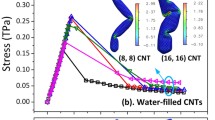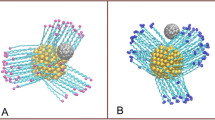Abstract
We report on electronic properties of water-filled fullerenes [H2O(n)@C60, H2O(n)@C180, and H2O(n)@C240] under mechanical deformation using density functional theory. Under a point load, energy gap change of empty and water-filled fullerenes is investigated. For C60 and H2O(n) @C60, the energy gap decreases as the tensile strain increases. For H2O(n)@C60, under compression, the energy gap decreases monotonously while for C60, it first decreases and then increases. Similar behavior is observed for other empty (C180 and C240) and water-filled [H2O(n) @C180 and H2O(n)@C240] fullerenes. The energy gap decrease of water-filled fullerenes is due to the increased interaction between water and carbon wall under deformation.





Similar content being viewed by others
References
K. Kurotobi and Y. Murata: A single molecule of water encapsulated in fullerene C60. Science 333, 613 (2011).
A. Weidinger, M. Waiblinger, B. Pietzak, and T.A. Murphy: Atomic nitrogen in C60: N@ C60. Appl. Phys. A 66, 287 (1998).
O.V. Pupysheva, A.A. Farajian, and B.I. Yakobson: Fullerene nanocage capacity for hydrogen storage. Nano Lett. 8, 767 (2007).
H. Shen: The compressive mechanical properties of C60 and endohedral M@ C60 (M=Si, Ge) fullerene molecules. Mater. Lett. 60, 2050 (2006).
K. Min, A.B. Farimani, and N. Aluru: Mechanical behavior of water filled C60. Appl. Phys. Lett. 103, 263112 (2013).
A.B. Farimani, Y. Wu, and N. Aluru: Rotational motion of a single water molecule in a buckyball. Phys. Chem. Chem. Phys. 15, 17993 (2013).
R. Rivelino and F. de Brito Mota: Band gap and density of states of the hydrated C60 fullerene system at finite temperature. Nano Lett. 7, 1526 (2007).
S.L. Kawahara, J. Lagoute, V. Repain, C. Chacon, Y. Girard, S. Rousset, A. Smogunov, and C. Barreteau: Large magnetoresistance through a single molecule due to a spin-split hybridized orbital. Nano Lett. 12, 4558 (2012).
Z.H. Ni, T. Yu, Y.H. Lu, Y.Y. Wang, Y.P. Feng, and Z.X. Shen: Uniaxial strain on graphene: Raman spectroscopy study and band-gap opening. ACS Nano 2, 2301 (2008).
L. Yang, M. Anantram, J. Han, and J. Lu: Band-gap change of carbon nanotubes: effect of small uniaxial and torsional strain. Phys. Rev. B 60, 13874 (1999).
E. Scalise, M. Houssa, G. Pourtois, V. Afanas’ev, and A. Stesmans: Strain-induced semiconductor to metal transition in the two-dimensional honeycomb structure of MoS2. Nano Res. 5, 43 (2012).
J.M. Soler, E. Artacho, J.D. Gale, A. García, J. Junquera, P. Ordejón, and D. Sánchez-Portal: The SIESTA method for ab initio order-N materials simulation. J. Phys.: Condens. Matter 14, 2745 (2002).
T. Dumitrică, T. Belytschko, and B.I. Yakobson: Bond-breaking bifurcation states in carbon nanotube fracture. Journal of Chem. Phys. 118, 9485 (2003).
P.W. Leu, A. Svizhenko, and K. Cho: Ab initio calculations of the mechanical and electronic properties of strained Si nanowires. Phys. Rev. B 77, 235305 (2008).
M. Topsakal and S. Ciraci: Elastic and plastic deformation of graphene, silicene, and boron nitride honeycomb nanoribbons under uniaxial tension: a first-principles density-functional theory study. Phys. Rev. B 81, 024107 (2010).
W. Ye, K. Min, P.P. Martin, A.A. Rockett, N. Aluru, and J.W. Lyding: Scanning tunneling spectroscopy and density functional calculation of silicon dangling bonds on the Si (100)-2× 1: H surface. Surf. Sci. 609, 147 (2012).
B. Kumar, K. Min, M. Bashirzadeh, A.B. Farimani, M.-H. Bae, D. Estrada, Y.D. Kim, P. Yasaei, Y.D. Park, and E. Pop: The role of external defects in chemical sensing of graphene field-effect transistors. Nano Lett. 13, 1962 (2013).
A.B. Farimani, K. Min, and N.R. Aluru: DNA base detection using a single-layer MoS2. ACS Nano 8, 7914 (2014).
A. Seidl, A. Görling, P. Vogl, J.A. Majewski, and M. Levy: Generalized Kohn–Sham schemes and the band-gap problem. Phys. Rev. B 53, 3764 (1996).
S. Lany and A. Zunger: Many-body GW calculation of the oxygen vacancy in ZnO. Phys. Rev. B 81, 113201 (2010).
J.P. Perdew, K. Burke, and M. Ernzerhof: Generalized gradient approximation made simple. Phys. Rev. Lett. 77, 3865 (1996).
B. Hammer, L.B. Hansen, and J.K. Nørskov: Improved adsorption energetics within density-functional theory using revised Perdew–Burke–Ernzerhof functionals. Phys. Rev. B 59, 7413 (1999).
N. Troullier and J.L. Martins: Efficient pseudopotentials for plane-wave calculations. Phys. Rev. B 43, 1993 (1991).
P. Valentini, W. Gerberich, and T. Dumitrică: Phase-transition plasticity response in uniaxially compressed silicon nanospheres. Phys. Rev. Lett. 99, 175701 (2007).
P. Calaminici, G. Geudtner, and A.M. Köster: First-principle calculations of large fullerenes. J. Chem. Theory Comput. 5, 29 (2008).
R.R. Zope and T. Baruah, M.R. Pederson and B. Dunlap: Static dielectric response of icosahedral fullerenes from C_ {60} to C_ {2160} characterized by an all-electron density functional theory. Phys. Rev. B 77, 115452 (2008).
A. Kokalj: Computer graphics and graphical user interfaces as tools in simulations of matter at the atomic scale. Comput. Mater. Sci. 28, 155 (2003).
Author information
Authors and Affiliations
Corresponding author
Supplementary materials
Supplementary materials
For supplementary material for this article, please visit http://dx.doi.org/10.1557/mrc.2015.22
Rights and permissions
About this article
Cite this article
Min, K., Farimani, A.B. & Aluru, N.R. Mechanically modulated electronic properties of water-filled fullerenes. MRS Communications 5, 305–310 (2015). https://doi.org/10.1557/mrc.2015.22
Received:
Accepted:
Published:
Issue Date:
DOI: https://doi.org/10.1557/mrc.2015.22




